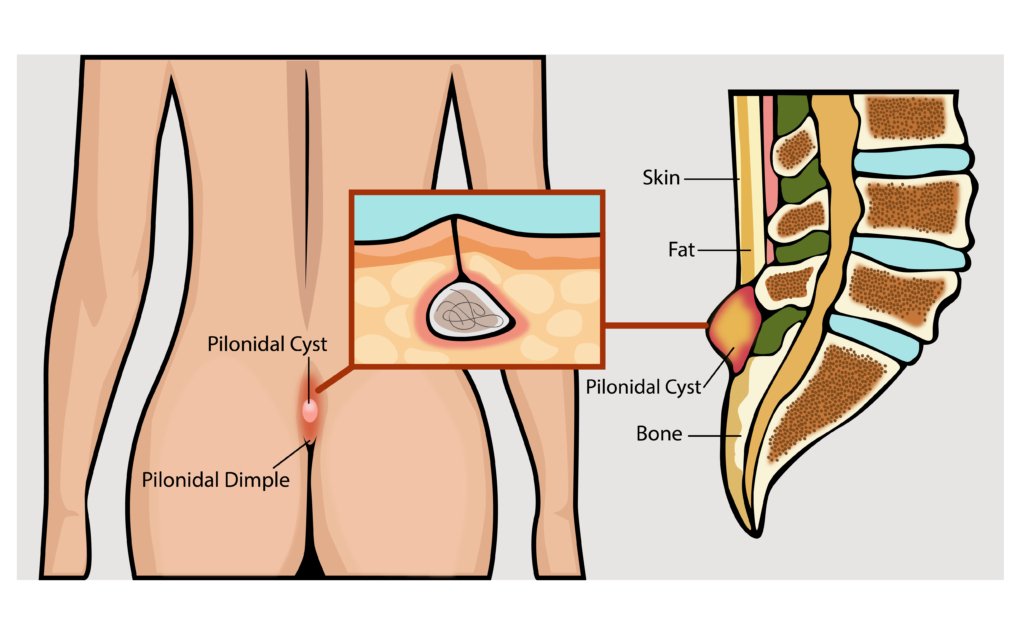Pilonidal Cyst Surgery Procedures and Recovery
Ask the Experts

Pilonidal sinus surgery is a procedure to remove a pilonidal sinus. A pilonidal sinus is a small tunnel or hole that develops in the skin, usually at the top of the crease between the buttocks. The condition is most commonly seen in men and can be caused by hair puncturing the skin and becoming embedded. Symptoms may include pain, swelling, redness, and discharge.
The surgery is usually performed under general anesthesia as an outpatient procedure. The surgeon will make an incision in the affected area and remove the sinus, including any hair or debris. The wound will then be closed with sutures or staples, and may be left open to heal by secondary intention. Recovery time for the surgery is typically several weeks, during which time the patient should avoid sitting for long periods of time and may be prescribed antibiotics and pain medication.
Endoscopic ablation for a pilonidal sinus
Endoscopic ablation is a minimally invasive surgical technique that can be used to treat a pilonidal sinus. Instead of making a large incision in the skin, as is typically done in traditional pilonidal sinus surgery, an endoscope (a small camera and light on a thin tube) is inserted into the sinus through a small incision. The endoscope allows the surgeon to view the inside of the sinus and remove any debris or abnormal tissue.
The ablation is done by using an endoscopic laser or cautery device to remove the lining of the sinus, and the debris and hair inside it, and this causes a controlled and quicker healing of the wound.
Like traditional Pilonidal Sinus Surgery, endoscopic ablation is typically performed under general anesthesia and recovery time is several weeks. Patients may experience less pain and a shorter recovery time with endoscopic ablation compared to traditional surgery. Additionally, since the incision is smaller, there may be less scarring after the procedure.
It is important to note that endoscopic ablation is not as widely available as traditional surgery and not all surgeons have expertise in it. It is not the best option for everyone and a thorough evaluation by a general surgeon or a colorectal surgeon is needed to decide which technique suits a patient the best.
How long does it take to recover from pilonidal cyst surgery?
Recovery time after pilonidal cyst surgery varies depending on the type of surgery performed, the patient's overall health, and the extent of the condition.
After traditional surgery, the recovery time typically ranges from 4-8 weeks. During this time, patients may experience pain and discomfort in the surgical area and may be prescribed pain medication to help manage symptoms. It's important to avoid sitting for prolonged periods of time, as well as any activities that put pressure on the affected area to avoid reopening of the wound. Most patients can return to work and normal activities within a few weeks, but it may take a few months for the wound to fully heal.
For endoscopic ablation, recovery time might be slightly shorter, and most of the patients can return to work within two to three weeks, but the healing process may take longer. Recovery times can vary widely and will depend on the patient's overall health, the extent of the surgery, and how well the patient follows post-operative instructions.
It is always recommended to follow the instructions given by your surgeon and to keep in touch with him/her during the recovery process, as he will be able to give you a more specific and personalized recovery time depending on your case.
Treatment Options:
- Wide excision of pilonidal sinus
- Laser pilonidoplasty ( lpp )
- Excision with primary closure
- Z-plasty
- Cleft lift / modified karyadakis / cleft closure
- Limberg flap / gluteal flap
Ask the Experts
Working Time
- Mon-Sat 09:00 - 19:00
Contact Info
-
Phone: +91 8121 200 400
+91 8121 800 400


